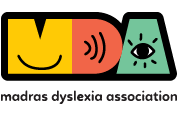
Link Between Primitive Reflexes and Dyslexia: An Occupational Therapy Perspective
Early Intervention Occupational Therapy Services offered by MDA
By Niveditha GS, Occupational Therapist, Madras Dyslexia Association
Primitive reflexes are automatic movement patterns originating from the brainstem that are present at birth and serve to support survival, sensory-motor development, and the early formation of postural control. These reflexes are meant to be temporary; as a child grows and matures, they should integrate (or be inhibited) to make way for more complex voluntary movements, higher cognitive functions, and efficient sensory processing. However, when these primitive reflexes are retained beyond the appropriate developmental window, they can interfere with the acquisition of academic and functional skills—including those related to reading, writing, attention, and motor coordination.
From an occupational therapy perspective, unintegrated primitive reflexes are increasingly recognised as a contributing factor to neurodevelopmental challenges, including dyslexia, ADHD, and difficulties in executive functioning. Dyslexia, in particular, affects a child’s ability to decode written language, connect letters to their corresponding sounds, and exhibit fluent reading and spelling skills. While dyslexia has been classically viewed as a language-based learning disorder, emerging research and clinical evidence suggest that the presence of retained primitive reflexes may play a role in the underlying neurophysiological dysfunction that contributes to learning difficulties.
Role of Primitive Reflexes in Early Development
During infancy, primitive reflexes provide a neurological foundation for movement, postural control, and sensory exploration. Reflexes such as the Moro reflex, Asymmetrical Tonic Neck Reflex (ATNR), and Tonic Labyrinthine Reflex (TLR) serve crucial roles in early life. For instance, the Moro reflex prepares the infant to respond to environmental stimuli; the ATNR promotes eye-hand coordination and body awareness; and the TLR helps establish postural tone related to the head’s position in space.
If these reflexes are not naturally integrated by the age of 12 months to 3 years, they may interfere with a child’s ability to perform age-appropriate motor and cognitive tasks. In school-aged children, these persistent reflexes can manifest as difficulties in coordination, poor postural control, poor eye tracking, reduced attention span, and frustration with academic tasks—all of which are commonly seen in children with dyslexia.
Key Reflexes Impacting Dyslexia
1. Moro Reflex
The Moro reflex is also known as the ‘startle’ reflex. It is triggered by sudden changes in the environment, such as loud sounds or unexpected movements. In children with retained Moro reflexes, the nervous system remains in a heightened state of arousal, leading to increased anxiety, poor impulse control, hypersensitivity to sensory stimuli, and difficulty sustaining attention.
In dyslexic children, this may present as a constant fight-or-flight response, making it hard for them to focus on classroom instructions, sit still, or cope with even minor academic stress. Learning new skills becomes challenging when the nervous system is chronically overactivated.
2. Asymmetrical Tonic Neck Reflex (ATNR)
ATNR is often referred to as the ‘fencing reflex’. When the head turns to one side, the arm and leg on that side extend, while the opposite limbs flex. This reflex plays a role in developing cross-body awareness in infancy.
If retained, ATNR can disrupt bilateral coordination, making it hard for children to use both hands together or cross the midline effectively. In dyslexia, this often shows up as left-right confusion, difficulty tracking words across a page, and poor handwriting. The child may also turn their head while writing or reading, resulting in distorted posture and visual strain.
3. Tonic Labyrinthine Reflex (TLR)
TLR relates to the position of the head in space and affects muscle tone and balance. When the head moves forward or backward, the body responds with either flexion or extension.
A retained TLR can cause challenges in balance, spatial orientation, and postural stability. In a classroom setting, this may present as poor sitting posture, low muscle tone, slouched shoulders, and difficulty maintaining visual focus—especially for reading tasks that require sustained eye tracking and convergence.
Interconnectedness of Reflexes
One important aspect of reflex integration is that these reflexes are interconnected. If one remains unintegrated, it can interfere with the suppression of others, creating a cascading effect on the child’s neurological and functional development. For example, a retained Moro reflex may perpetuate ATNR, which in turn may interfere with TLR integration. This complex interdependency often results in a mixed clinical picture involving academic, behavioral, and sensory-motor delays.
Evidence-Based Support
Several studies support the connection between retained primitive reflexes and learning difficulties. Notably:
• A study titled ‘Prevalence of Persistent Primitive Reflexes and Motor Problems in Children with Reading Difficulties’ found that children with reading difficulties had a significantly higher prevalence of unintegrated reflexes compared to their peers.
• Another cross-sectional study, ‘Primitive Reflexes Persistence in Children with Reading Difficulties,’ supports the association between retained reflexes and impaired academic performance, particularly in reading and writing.
These findings highlight the importance of screening for primitive reflexes in children presenting with dyslexia and other learning disorders.
The Occupational Therapy Approach
Occupational therapists play a vital role in identifying and addressing retained reflexes through rhythmic movement-based interventions, sensory integration strategies, and neurodevelopmental techniques. Reflex integration exercises target specific patterns such as starfish, rolling, lizard, and midline crossing to promote new neural connections and target the root reflex.
More importantly, the therapy process incorporates a trauma-informed lens to ensure emotional safety, choice, and regulation, as many children with learning challenges experience secondary emotional stress. By combining structured movement, emotional support, and an occupation-based framework (such as MOHO), therapists can promote meaningful participation in academic and daily life.
A Message of Hope
The encouraging news is that it is never too late to work on reflex integration. Neuroplasticity allows the brain to form new connections throughout life, and with the right interventions, children can improve focus, reading fluency, coordination, and confidence.
In conclusion, while dyslexia is commonly seen as a language-based disorder, it’s essential to understand the foundational role of movement and brainstem-level reflexes in a child’s ability to learn. As occupational therapists, we have the tools to bridge this gap, offering a whole-child approach that addresses not just the ‘what’ of learning difficulties, but also the ‘why’.
References:
1. Konicarova, J., & Bob, P. (2013). Prevalence of Primitive Reflexes in ADHD and Reading Disorder. Neuropsychiatric Disease and Treatment.
2. Blythe, S. (2005). Releasing Educational Potential through Movement. Journal of INPP.
3. Goddard-Blythe, S. (2009). Attention, Balance and Coordination: The A.B.C. of Learning Success.
4. Melillo, R. (2011). Disconnected Kids: The Groundbreaking Brain Balance Program for Children with Autism, ADHD, Dyslexia, and Other Neurological Disorders.
